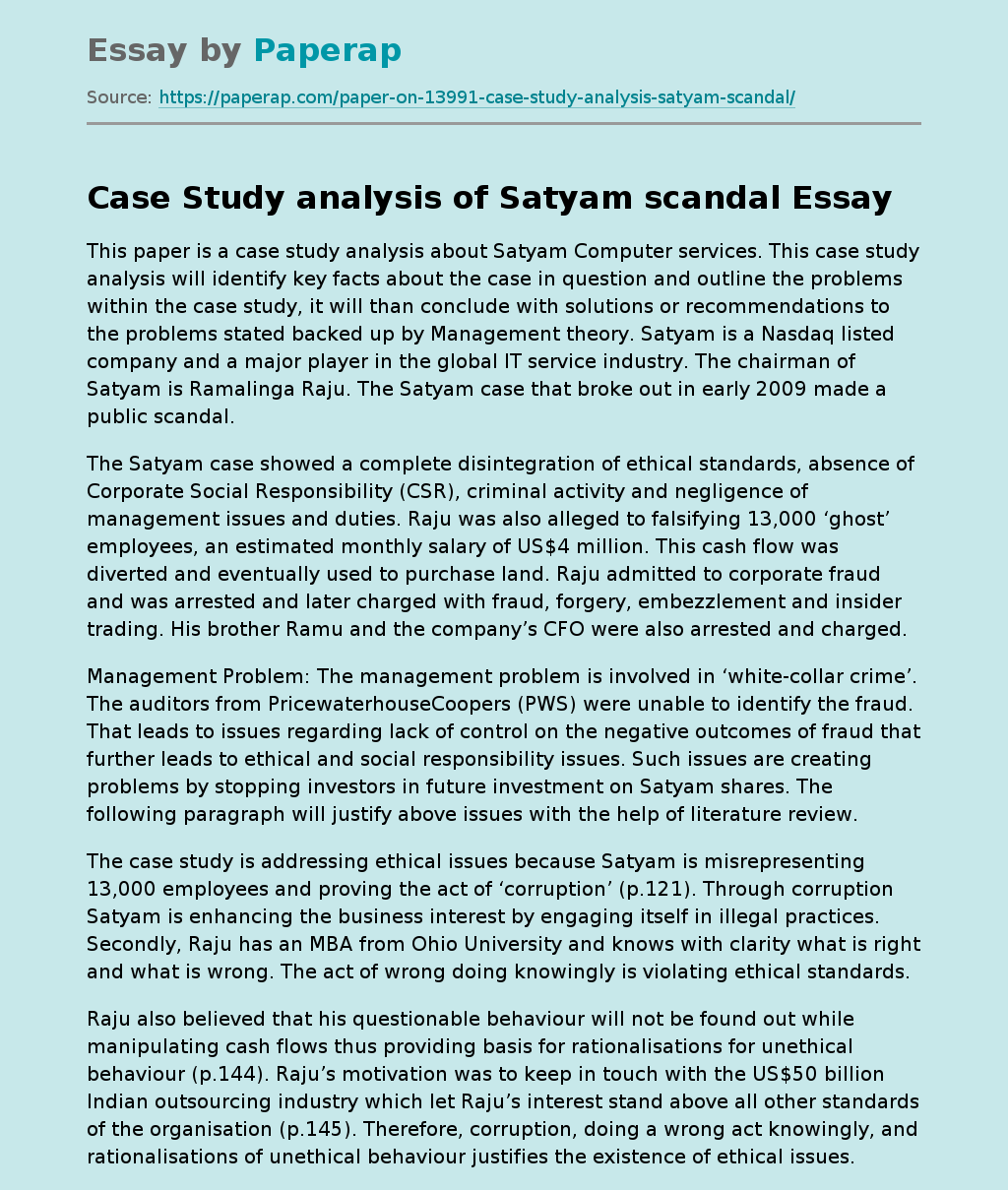Case Study analysis of Satyam scandal
This paper is a case study analysis about Satyam Computer services. This case study analysis will identify key facts about the case in question and outline the problems within the case study, it will than conclude with solutions or recommendations to the problems stated backed up by Management theory. Satyam is a Nasdaq listed company and a major player in the global IT service industry. The chairman of Satyam is Ramalinga Raju. The Satyam case that broke out in early 2009 made a public scandal.
The Satyam case showed a complete disintegration of ethical standards, absence of Corporate Social Responsibility (CSR), criminal activity and negligence of management issues and duties. Raju was also alleged to falsifying 13,000 ‘ghost’ employees, an estimated monthly salary of US$4 million. This cash flow was diverted and eventually used to purchase land. Raju admitted to corporate fraud and was arrested and later charged with fraud, forgery, embezzlement and insider trading. His brother Ramu and the company’s CFO were also arrested and charged.
Management Problem: The management problem is involved in ‘white-collar crime’. The auditors from PricewaterhouseCoopers (PWS) were unable to identify the fraud. That leads to issues regarding lack of control on the negative outcomes of fraud that further leads to ethical and social responsibility issues. Such issues are creating problems by stopping investors in future investment on Satyam shares. The following paragraph will justify above issues with the help of literature review.
The case study is addressing ethical issues because Satyam is misrepresenting 13,000 employees and proving the act of ‘corruption’ (p.
121). Through corruption Satyam is enhancing the business interest by engaging itself in illegal practices. Secondly, Raju has an MBA from Ohio University and knows with clarity what is right and what is wrong. The act of wrong doing knowingly is violating ethical standards.
Raju also believed that his questionable behaviour will not be found out while manipulating cash flows thus providing basis for rationalisations for unethical behaviour (p.144). Raju’s motivation was to keep in touch with the US$50 billion Indian outsourcing industry which let Raju’s interest stand above all other standards of the organisation (p.145). Therefore, corruption, doing a wrong act knowingly, and rationalisations of unethical behaviour justifies the existence of ethical issues.
The case study is also addressing the issue of corporate social responsibility (CSR) as the Raju’s fraudulent actions are negatively affecting the stakeholders of Satyam and the economy as a whole. The Satyam case is violating ‘Financial Responsibility’ and ‘social/community responsibility’. Satyam activities lack of transparency due to neglecting moral reasons is creating trustworthiness, dependability and credibility issues for the organisation.
Recommendations: Due to the ethical dilemma’s that occurred in Satyam I would recommend the company and its auditors firstly conduct a formal and full investigation into the workings of the company to pin point and identify just how far into the company these issues are. Secondly Ethics training (146) in the form of an ethical decision making model would be introduced to the company and all employees would be trained and confident in being able to make decisions in an ethical manner. An example of an ethical decision making model is the “Six steps to ethical decision making” model. A course of action like this ensures that ethical decision making in regards to the company is seen as a big issue internally in the company and every employee has a good grasp and understanding of what is seen as ethical and unethical behaviour.
In the case of the CSR issues Satyam has lost the trust of its stakeholders, a solution to reclaiming that trust is transparency, as a publically traded company that held secrets that nearly led to the demise of the company. Satyam should become a more public company and show more of their work to the public through use of forums, information sessions and general advertising to earn that trust back by their stakeholders. Internally the company needs to continually raise awareness of CSR at every opportunity, develop a Credo and shared values and constantly restate these at every opportunity through forums, information sessions etc and incorporating these principles into all training.
Though Professor Sudhakar Balachandran still argues that the traditional measures that are relied on to stop this sort of behaviour (e.g corporate governance, auditing and legal consequences) is not good enough and stricter penalties need to be introduced. His argument is that “white collar crime is just as bad as any other crime” and should therefore have stricter penalties as a deterrent. Satyam obviously has no control of the legal consequences of such actions but in taking Professor Balachandrans opinion into consideration a strong course of action would be for Satyam to take a hard line on anyone neglecting these values and any breach of them however big or small should be immediately reported and examined both internally in the company and externally through the auditors before consequences are implemented, strict internal penalties for breaching the companies values need to be introduced and everyone in the organisation must be well informed of the consequences.
Conclusion: In conclusion this case study analysis introduced the Satyam scandal of 2009, and highlighted for the reader what the major issues were regarding the case and recommended solutions such as education, training and stricter penalties to help deter and potentially put a stop to incidents such as this in the future.
Reference list:
Shermerhorn, Davidson, Poole, Simon, Woods, Chau ‘Management foundations and applications’
https://learning.secure.griffith.edu.au/webapps/portal/frameset.jsp?tab=community&url=%2Fbin%2Fcommon%2Fcourse.pl%3Fcourse_id%3D_53067_1
https://learning.secure.griffith.edu.au/webapps/portal/frameset.jsp?tab=community&url=%2Fbin%2Fcommon%2Fcourse.pl%3Fcourse_id%3D_53067_1
Case Study analysis of Satyam scandal. (2018, Feb 06). Retrieved from https://paperap.com/paper-on-13991-case-study-analysis-satyam-scandal/

